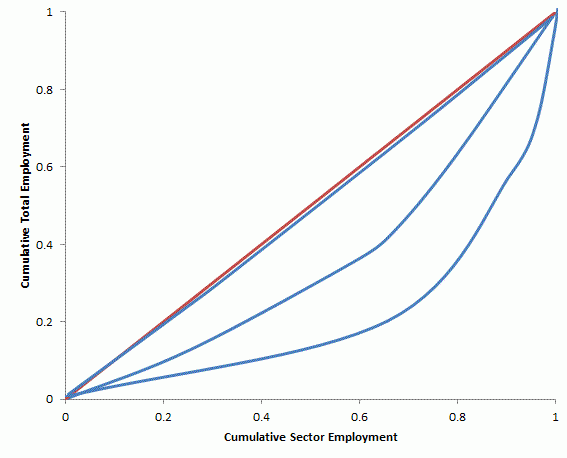Selective Cuttings
The Canadian forest sector is important from coast to coast
January 23, 2014
The forest sector is often touted as a national sector, important in all regions of Canada. Localisation curves provide a convenient way to quantify this, comparing the distribution of forest sector employment directly with other sectors. They show how concentrated employment is in a given region, rather than just the total size of employment.
In general, firms locate production in a given region to leverage competitive advantages. The Canadian auto sector is highly concentrated in southern Ontario in order to feed parts into the U.S. auto sector that was traditionally dominated by Detroit. The energy sector is focused on parts of the country with abundant energy resources, such as the oil sands in Alberta. Sectors of the economy that are focused on services (such as health care and education) tend to be focused in major population centres, where the density of the consumers of their products is highest.
Concentration of employment in a given sector has an impact on how the sector is perceived at a national level. When the impacts of an economic sector are broadly distributed it is easier to develop national consensus about that sector’s importance, and that sector will tend to be closely identified with national identity and interests – these sectors are part of the everyday lives of Canadians, and fluctuations are felt by everybody. Examples include health, education, and retail. On the other hand, when benefits are concentrated in a particular constituency, beneficiaries often have strong incentives to promote that sector, but it is difficult to build consensus with other constituencies who benefit less. Examples includes many natural resource sectors, including mining and energy.
Despite the wide range of forest types, differentials in market access, and historical investment patterns, the employment benefits of the forest sector are fairly evenly spread throughout Canada. One of the more convenient ways to quantify this distribution of benefits is through the use of the Localisation Coefficient, derived from localisation curves. Construction of a localisation curve is relatively straightforward. In a Canadian context, sector employment in each region (Atlantic, Quebec, Ontario, Prairie and British Columbia) is expressed as a share of total national sector employment, the cumulative sum of which is expressed on the x-axis. Then total employment in each region is expressed as a share of total national employment and its cumulative sum is expressed on the y-axis.
Localisation curves for select Canadian sectors (2012)

The degree of concavity of the localisation curve for a given sector demonstrates how concentrated employment for that sector is in a given region. For instance, services (such as education) tend to be distributed very evenly at a near constant ratio to population size and therefore have nearly perfectly linear localisation curves. For primary manufactures closely tied to a relatively unevenly distributed resource (such as energy) the degree of concavity is quite high. Forestry lies somewhere in between. The localisation coefficient (LC) is a way of expressing the meaning of a localisation curve in a single number: the area between the 45° line and the localisation curve divided by 0.5 (the total area under the 45° line). An LC of 0.0 would represent a sector with perfectly evenly distributed employment, while an LC of 1.0 indicates a sector completely localized in a single region. For 2012, the Canadian education sector had an LC of 0.02, the forest sector 0.28 and the energy sector 0.54.The LC can also be used to express how the distribution of employment sector benefits are changing over time: in 1992 the forest sector LC was 0.34. The decline to 0.28 in 2012 implies that over the past 20 years forest sector employment has become less concentrated in one or two parts of the country, becoming a more truly national sector.
In general, these results support the idea that, moreso than other industrial sectors, the forest industry is truly national in scope, and impacts the lives of a broader range of Canadians and communities.
